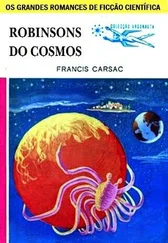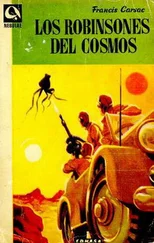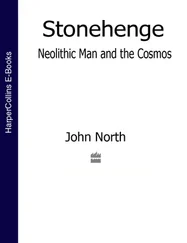Now we talk about time.
It would seem that what time is? It is a certain value independent of a person that is not paid special attention in everyday life. The main thing is not to be late somewhere. Previously, at least the wall clock was ticking, recalling that certain changes were taking place in our lives, independent of us. From time to time we suddenly discovered that we were older, that something had changed around us. Everything seems to be the same as before, but suddenly we find that certain changes have occurred.
But it turns out time is not as simple as we think about it. Many paradoxes are associated with it, and these are paradoxes of a cosmic scale. For example, such a paradox. It turns out that precisely in space, time is measured not in hours, as on Earth, but in the same values in which length, width and height are usually measured – in kilometers.
Another paradox of time.
In our ordinary life, “yesterday” cannot be seen, but it turns out to be possible in space. We are looking into the sky now, this very minute, and we see cosmic objects as they were yesterday, the day before, several years ago, depending on the distance to them. For example, the closest star to us, Alpha Centauri, is located so far from us that the light from it comes to us for 4 years. If it suddenly goes out, then for us it will shine for another four years. In space, you can see any day, any year in the past, it is enough to point the telescope at stars located at an appropriate distance from the observer.
But let’s start with simple things, as time is connected with movement. What is characteristic of movement is the starting point, the beginning of the movement and the ending point, which is located at some distance from the beginning of the movement. To overcome this distance between two points takes some time. In this case, time is directly related to the distance. Therefore, space is not only length, width and height, but necessarily time, because space is necessarily movement. Energy is also directly connected with movement except time.
Everything moves in the Universe, starting with the expansion of the Universe itself and ending with the movement of photons or the speed of light. But what is interesting: if the speed light is measured and is itself a standard for measurement, then the expansion of the Universe is more difficult to fix.
I will clarify here: I believe the Universe is a sphere formed as a result of the Big Bang, in contrast to the point of view that our Universe is flat, like a blanket. So, the Universe is constantly expanding. Expansion occurs not only along the radius from the Big Bang epicenter, but also along the perimeter of the energy impulse, since it spreads in all directions. It is as if the balloon is inflated, and the distance between the flowers painted on it increases.
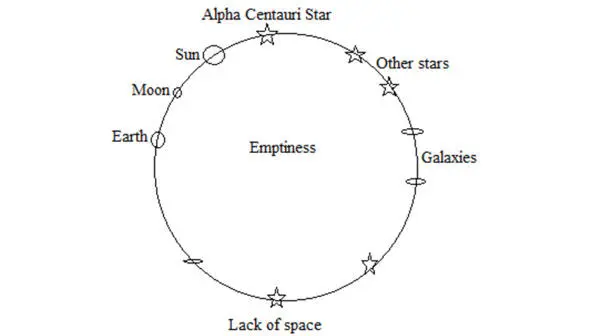
It is believed that all objects of the Universe: stars, galaxies, nebulae are located on a thin film of the energy impulse formed as a result of the initial Big Bang. These space objects are flowers on the surface of the expanding ball. The similarity with the inflatable ball also increases because, as in the ball, the void inside and outside and all objects of the Universe are located only on the surface of the energy impulse, and inside and outside the void. I will try to depict this in the picture.
I suppose that inside and outside the sphere is not just emptiness, but there is nothing at all from the point of view of physical space. All spatial geometry of the Universe is enclosed in this energy impulse. Outside the surface of the sphere of the Universe, space turns into time literally. Here the design of our physical world changes in the most unusual way.
Why then do we not see this emptiness, but see the stars everywhere: at the top, at the bottom, and at the center? Something like this:
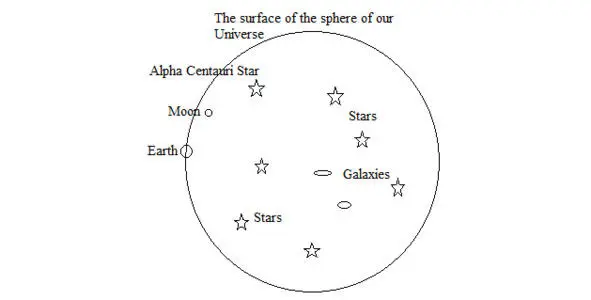
This is precisely one of the paradoxes of time, which directly connects time with space.
I repeat once again – the Universe is just the perimeter of the expanding energy impulse, and all space objects are on its surface.
What is characteristic of these space objects? They are all located at the same distance from the epicenter of the Big Bang and, therefore, they all have the same time. Of course, they rotate, change position relative to each other. But, since the Universe is huge in itself, all these fluctuations of space objects do not play a big role in terms of a common and uniform time for the Universe. The Universe is continuously expanding along the radius but all space objects are moving away from the epicenter at the same speed, therefore time in the whole Universe is the same.
But the paradox is that, being in the same present time, these space objects in this present time do not see each other. Although they have the same time, however, they are at different distances from each other around the perimeter of the energy impulse. Let’s call it the present time distance. Some of them are closer to each other, others farther. There are very remote objects. The observer at each of them in the present tense sees only himself. Any other space object that seems to be in the same present tense, he sees only when the light from this object reaches the observer. And what is very important: the impact of one space object on another occurs only when the energy impulse of this object reaches another object. It is the same speed of light. That is, it turns out that one space object, being in the same time with another space object, learns about its existence only in the past tense. Since space objects are located at different distances from each other, then the time spent by light to overcome this distance will be different. And these cosmic objects in the night sky will line up in front of the observer in accordance with the distance to the observer on the surface of the sphere of our Universe. The farther the distance around the perimeter of the energy pulse, on which all space objects, the longer the light goes to the observer, the more distant past tense the observer sees them. The most distant objects can be correlated in time with a moment close to the Big Bang. And on the surface of the sphere of our Universe it will be the farthest located space objects from the observer. It turns out that we see the most distant stellar objects as they were more than 13 billion years ago and we will know what they are now only after the next 13 or more billions of years.
Another question arises, but will the observer see those cosmic objects that are beyond the horizon of the sphere, because the Universe is still a sphere, not a flat blanket, but the light moves in a straight line?
Since the physical world is arranged so that the observer sees only light, and the instruments register only the electromagnetic radiation of the source, it turns out that the observer sees the world around him only in the past tense. And in the present tense is only the observer himself. Of course, what is at arm’s length is conditionally considered to be real, but here the starry sky is exactly the past time.
It turns out that the present is just a point, and this point is an observer. Generally speaking, the surface of our Universe is completely the real time sphere, but it consists of many separate points of conditional observers or receivers of electromagnetic radiation. How can one not recall the mathematical definition of a straight line, that this is just a collection of points.
In general, geometrically, space is some kind of construction where the space around the perimeter of the energy impulse, with the same time, is not the same for each space object separately. That is, the real present time exists only in the space object itself, and the space around it exists exclusively in the past tense.
Читать дальше





